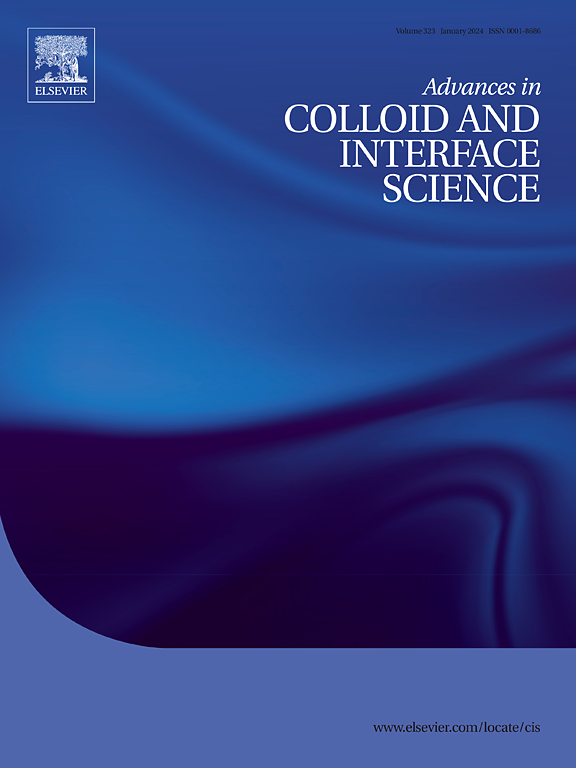双乳皮克林稳定:基本概念,原理,制备,潜在应用,挑战和未来展望
IF 15.9
1区 化学
Q1 CHEMISTRY, PHYSICAL
引用次数: 0
摘要
双乳液(DEs)具有独特的区隔结构,但本质上不稳定,促使科学和工业努力提高其稳定性。一种很有前景的策略是使用固体颗粒——被称为皮克林稳定剂——产生皮克林双乳液(pde),它克服了传统低分子量(LMW)表面活性剂的许多局限性。然而,在文献中,术语“皮克林”经常被误用来描述任何含有颗粒的配方,而不管界面是否被它们完全稳定。本文旨在澄清皮克林稳定化的概念,概述其应用于DEs的基本原理,并研究制备机制,界面方法,潜在应用和当前的挑战。具有双重润湿性和高解吸能的颗粒在界面上不可逆地吸附,形成坚固的机械屏障,抑制聚结,减少内部液滴的扩散或逃逸。pde可以通过两步乳化、一步工艺或先进的微流体方法制备。各种皮克林方法已经被开发出来,用于设计能够双重界面稳定的颗粒,实现复杂的功能,如(共)封装,控释,以及形成微球,胶体体和抗气泡等分层结构。为了释放pde在工业应用中的全部潜力,未来的研究应优先考虑消除表面活性剂的使用,开发安全和可持续的颗粒,并在不影响乳液稳定性或性能的情况下推进可扩展的生产方法。本文章由计算机程序翻译,如有差异,请以英文原文为准。

Pickering stabilization of double emulsions: Basic concepts, rationale, preparation, potential applications, challenges, and future perspectives
Double emulsions (DEs) offer unique compartmentalized structures but are inherently unstable, prompting significant scientific and industrial efforts to enhance their stability. One promising strategy is the use of solid particles—known as Pickering stabilization—resulting in Pickering double emulsions (PDEs), which overcome many limitations of conventional low-molecular-weight (LMW) surfactants. However, the term “Pickering” is often misused in the literature to describe any formulation containing particles, regardless of whether the interface is fully stabilized by them. This review aims to clarify the concept of Pickering stabilization, outline the rationale for its application to DEs, and examine preparation mechanisms, interfacial approaches, potential applications, and current challenges.
Particles with dual wettability and high desorption energy irreversibly adsorb at interfaces, forming robust mechanical barriers that inhibit coalescence and reduce diffusion or escape of internal droplets. PDEs can be prepared via two-step emulsification, one-step processes, or advanced microfluidic methods. A variety of Pickering approaches have been developed to engineer particles capable of dual interfacial stabilization, enabling sophisticated functions such as (co-)encapsulation, controlled release, and the formation of hierarchical structures like microspheres, colloidosomes, and antibubbles. To unlock the full potential of PDEs for industrial applications, future research should prioritize eliminating surfactant use, developing safe and sustainable particles, and advancing scalable production methods without compromising emulsion stability or performance.
求助全文
通过发布文献求助,成功后即可免费获取论文全文。
去求助
来源期刊
CiteScore
28.50
自引率
2.60%
发文量
175
审稿时长
31 days
期刊介绍:
"Advances in Colloid and Interface Science" is an international journal that focuses on experimental and theoretical developments in interfacial and colloidal phenomena. The journal covers a wide range of disciplines including biology, chemistry, physics, and technology.
The journal accepts review articles on any topic within the scope of colloid and interface science. These articles should provide an in-depth analysis of the subject matter, offering a critical review of the current state of the field. The author's informed opinion on the topic should also be included. The manuscript should compare and contrast ideas found in the reviewed literature and address the limitations of these ideas.
Typically, the articles published in this journal are written by recognized experts in the field.

 求助内容:
求助内容: 应助结果提醒方式:
应助结果提醒方式:


